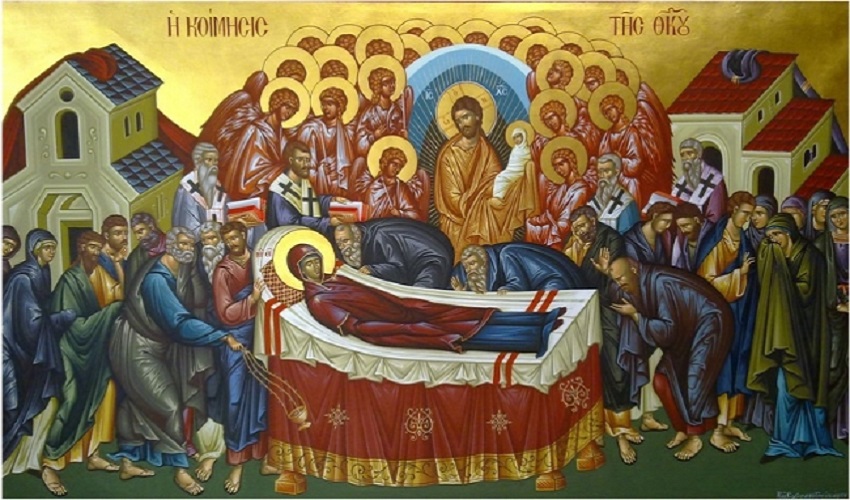The feast of the Mother of God of Christianity, the feast of the Assumption of the Virgin Mary is celebrated every year on the 15th of August.
In the Orthodox Christian Church, the celebration of the Assumption of the Virgin Mary includes, firstly, the death and burial of the Virgin Mary and, secondly, her resurrection and metastasis to heaven.
There is no information from the New Testament about the Assumption of the Virgin Mary.
We learn about this from the stories of important ecclesiastical men, such as St. John the Theologian, Dionysius the Areopagite, Modestus of Jerusalem, Andreas of Crete, German of Constantinople, John of Damascus, etc., as well as the relevant tropics of the church.
These texts preserve the “ancient and most true” tradition of the Church for this event pertaining to the Virgin.
So, according to church tradition, the mother of Jesus Christ, Mary was informed of her impending death by an angel three days before it happened and began to prepare properly.
She prayed on the Mount of Olives and gave her possessions to two of her widowed neighbors.
Because on the day of her Assumption not all the Apostles were in Jerusalem, as they were preaching elesewhere, a cloud seized them and brought them to her.
The only absentee was the Apostle Thomas.
The Assumption of the Virgin Mary took place in the house of the Evangelist John, in which the mother of God lived.
After closing her eyes, the Apostles transported her body to the garden of Gethsemane, where she was buried.
While transporting her remains, fanatical Jews tried to overturn her coffin, but were blinded.
Only one of them managed to touch it, but an invisible sword cut off his hands.
The only absentee from her funeral was, as mentioned above, the Apostle Thomas.
When, after three days, he went to her grave, he found it empty.
Apparently, the Virgin Mary had been resurrected.
A majestic church was built on her tomb, which is attributed to Saint Helen.
After its destruction, the Byzantine emperor Markianos (450-457) and his second wife Poulcheria built a new temple, which still exists today.
The Assumption of the Virgin Mary was originally celebrated on August 13 and from 460 on August 15.
There is a dogmatic difference between the Orthodox and the Catholic Church regarding the Assumption of the Virgin Mary.
The Catholic Church believes in the doctrine of the incarnate body of the Virgin (Assumptio Beatae Mariae Virginis), which was finalized with the apostolic circular of Pope Pius IB ’Munificentissimus Deus (November 1, 1950).
On the contrary, the Orthodox Church speaks first of the Assumption of the Virgin Mary, ie real death (separation of soul and body), and then of the Transfiguration of the Virgin, ie resurrection (union of soul and body) and her Ascension near her Son.
According to the ecclesiastical tradition, the feast of the Assumption of the Virgin Mary is preceded by fasting, which was established in the 7th century.
It was originally divided into two periods: before the feast of the Transfiguration of the Savior and before the feast of the Assumption of the Virgin.
In the 10th century they united in a fast, which lasts 14 days and begins on the 1st of August.
During this fast even oil is fasted except on Saturday and Sunday, while on the feast of the Transfiguration of the Savior fish are allowed.
On the day of the feast of the Assumption of the Virgin Mary, everything isallowed, unless the feast falls on a Wednesday or Friday, when only the fish is allowed.
During the fasting days of the 15th of August, the so-called “Prayers” are sung in the churches in the afternoon (except Sundays), alternately, “The Little and the Great Praying Canon to the Most Holy Theotokos”.
In Greece, the Assumption of the Virgin Mary is celebrated with great splendor, and is also called “Summer of Easter”.
In many Aegean islands (Tinos, Paros, Patmos) they decorate and carry an epitaph in honor of the Virgin Mary.
In towns and villages throughout the territory, in churches dedicated to the Assumption of the Virgin Mary, traditional festivals are organized, which end in a generalized feast.
The Assumption of the Virgin Mary is not a mourning event for the people, because the Virgin Mary “moved to life”.
Besides, Panagiotis, Maria and Despina celebrate on the 15th of August.
The feast of the Assumption of the Virgin Mary is celebrated in a less emphatic way in the other orthodox and catholic countries of the world, in most of which August 15 is an official holiday, as in Greece.
The Protestants confessions consider the Assumption of the Virgin Mary as a secondary holiday, because it is not based on biblical references.
This difference is evident in Germany, where August 15 is an official holiday only in the Catholic states of Saarland and Bavaria.



